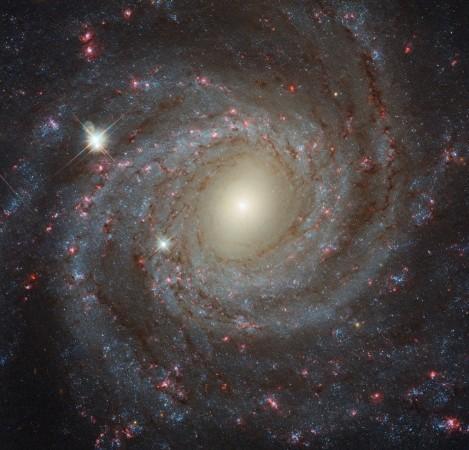
A spectacular spiral galaxy has been captured by NASA/ESA Hubble telescope, and is the perfect galactic Valentine, according to astronomers.
The galaxy, called NGC 3344, is located 20 million light years from Earth in the Leo Minor constellation. The astronomers got a chance to have a detailed look into the structure of the galaxy with the help of the Hubble Space Telescope.
Hubble's potential to detect distant celestial objects over a wide range of different wavelengths brought these features into light. Otherwise, they would have remained undiscovered.
Spiral galaxies are stunning galactic features that comprise of a flat, rotating disk of gas and debris along with a central concentration of stars called bulge. Spiral galaxies differ from each other.
The NGC 3344 galaxy is half the size of the Milky Way, and is classified as a weakly barred galaxy.
Two-thirds of all spiral galaxies are barred, including our Milky Way, according to the speculations by the astronomers.
Hubble had captured an elongated lane of stars trailing through the nucleus of the galaxy using its Wide Field Camera 3.
The image of NGC 3344 has been captured using different filters, ranging from the near-ultraviolet to the optical and the near-infrared. These filters helped in capturing a well-defined image of the galaxy, which the human eyes couldn't possibly see.
The remarkable image portrays glowing red phenomenon which can be seen present in the arms of the galaxy, they comprise of materials in abundance which are enough for more stars.
"The bright jewel-like stars on the left of the picture, however, are much closer to Earth — they belong to our own galaxy and just happened to photobomb this Hubble image," a NASA statement revealed.
The spinning arms of this mysterious galaxy are the birthplace of new stars that possess a blue gleam because of high temperatures, which makes them easily visible in this image.
It has been observed by astronomers that most of the outer stars of this galaxy are moving in a strange way. It has often been observed that the concentration of stars in the center of a galaxy can have an impact on the movements of the outer stars, but this was not the case in this spiral galaxy.
According to the guesstimation of the astronomers, the strangely-behaving outer stars might have been stolen from another galaxy post a close encounter that occurred long ago.
The Milky Way is a part of the galaxy group known as the Local Group, which comprises of around 40 galaxies. Interestingly the spiral galaxy NGC 3344 is not a part of the local galactic neighborhood.
This spiral galaxy is part of a small spur that leads off the larger Virgo Supercluster — a gargantuan collection of several thousand galaxies, NASA revealed.
NGC 3344's beauty makes it stand out among the thousands of galaxies detected so far.














